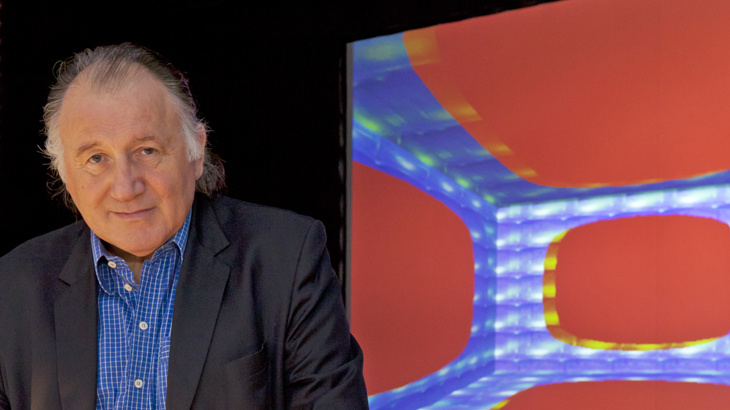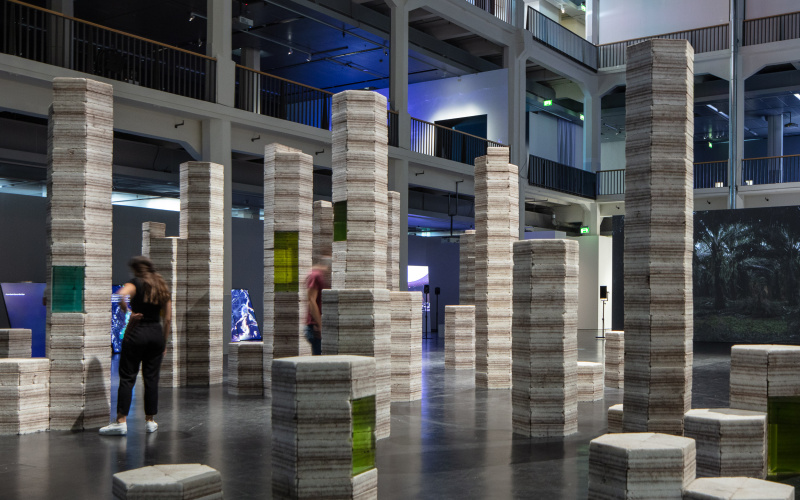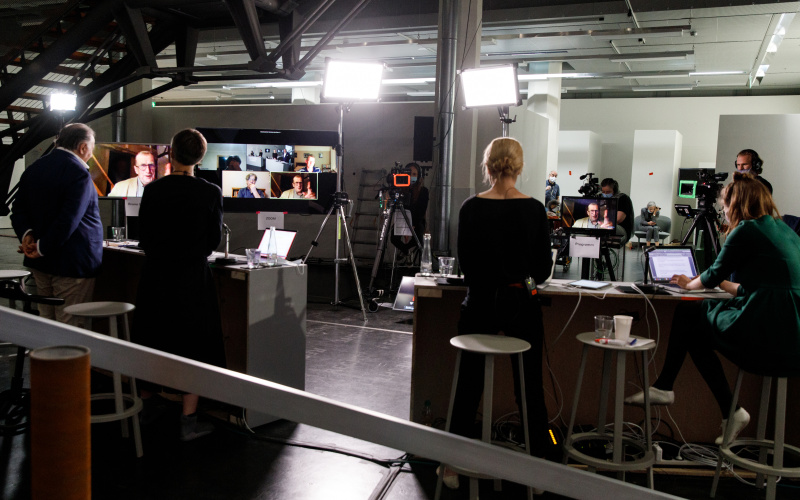Power to the People: Images by the People
VON PETER WEIBEL
Visual media were the media of art’s classical function, namely, that of representation. The replacement of visual media by social media signals action rather than representation, sharing and participation instead of reception, use as opposed to contemplation. Whoever communicates on the net sends pictures and text – he acts. He is part of a network of social actors. Today, we no longer talk of visual media, but of social media.
The theory and practice of participation, and the interaction between visitor and work of art represents the focal point of the ZKM’s museological concept. The ZKM’s self-understanding is a performative museum, an interactive museum reflecting interactive society – a democracy characterized by civic participation. In this connection, the power of the picture and the transformations effected by technical carrier media assumes a central role and, indeed, leads to a very interesting development which, today, has an effect on each one of us. The power of letters and of books prevailed for centuries. Their power was so extensive that, much like Holy Scripture, it was even sanctified. From the bible to Machiavelli, letters and books comprise the fiction of power. With the appearance of the joint technologies of picture and reproduction, letters, namely, writing lost its monopoly of power. The power of the picture began increasing with the appearance of photography from around the mid-nineteenth century. In short, with the advent of photography we entered “Ins Universum der technischen Bilder” into the universe of technical pictures [1]. The visual media of film, television, video and the computer developed from photography. Hence, painting lost the monopoly of picture production, but at the same time several other media began emerging, from human to mechanical picture production. The power of the picture became greater since, in addition to painting the new media began producing huge quantities of pictures. The power of the art picture dwindled because it remained locally bound. The pictures of the new media follow the logic of distribution. They are amenable to technical means of reproduction; they can be distributed and are received by a vast number of recipients almost simultaneously at different locations. Pictures as produced by painters only reach the public after being transformed into technical pictures, in media pictures e.g., in postcards or in photographic illustrations in books. As copies, photographs are, from the outset, multipliable from negatives. Photographs and films are unceasingly distributed to all locations of the world by way of newspapers or television stations. The majority of public pictures thus derive from the art world, the majority of which are no longer produced by single persons. Around 1950 the understanding was that the visual arts were not congruent with the realm of pictures. One hundred years after the invention of photography and the victory of technical pictures in mass media, it became evident that visual culture took in more than just the visual arts. Through the means of mass media, the realm of the picture exploded. An endless amount of pictures was generated over the decades, pictures of nature, pictures of catastrophes, of accidents, of politicians, of actors, of animals of consumer goods, of products, cities, factories, and people, none of which had anything to do with art. As a consequence, one it became clear that the history of pictures is not only the history of painting, but the universe of pictures extending way beyond painting a new subject became necessary. For this new universe of pictures, on which medicine and mathematics further developed by way of modern imaging methods in the natural sciences during the 1980s, the concept visual culture was introduced. Although the critical discussion between the visual arts and visual culture only first began to irrupt in the 1980s, the foundations for the debate had already been laid during the 1950s. Popular mass media picture material has permeated art ever since the Cubist and Dadaist collages. But popular picture culture only became perceptible through Pop Art. Eduardo Paolozzi’s collage I was a Rich Man's Plaything (1947) is commonly held to be the first example of Pop Art, at least of British Pop Art, which made its debut ten years prior to its North American incarnation. Paolozzi showed this collage as part of his series Bunk! in London, in 1952, in the context of the Independent Group, and to which Richard Hamilton also belonged – whom we have to thank for the world famous collage Just what is it that makes today's homes so different, so appealing? (1956). Incidentally, both collages use and show the world ‘pop.’ Around the same time a young professor of literature in Canada took a further unprecedented step: he no longer studied and analyzed high culture, as had been previously the case, but popular culture. In The Mechanical Bride. Folklore of Industrial Man (1951), Marshall McLuhan examined the impact of advertising on society by means of selected advertising pictures. Thus, McLuhan did not analyze art pictures, not pictures of art history, but advertising pictures so as to make statements about society. Hence, for a diagnosis of the era, for him, the visual culture of the mass media appeared more appropriate than did the pictures of art history. It was with the publication of this work that pop philosophy and research of visual culture really took off. The ascendency of the picture through mass media not only (with McLuhan) founded media theory, but brought about an entire new philosophy of the picture, from Martin Heidegger to Jean Baudrillard, from Günther Anders to Vilem Flusser. We observe a via triumphalis of the picture extending from pictures of art history to the pictures of visual media, from the visual arts to visual culture. Thus begins the chain of monopoly loss. The painters, visual artists and the producers of art pictures lost their hold over the picture to the photographers and video artists, to the computer artists, to the producers and distributers of technical pictures and to the visual mass media. With the appearance of the Internet, the crown jewel in the logic of distribution, the mass media and their owners lost the monopoly over the picture. The visual media lost the monopoly over the production and distribution of pictures to the user of social networks. Through the technical media, the class of artists lost their monopoly over creativity: “Everyone is an artist,” declared Joseph Beuys in 1970, and thus defined this loss of monopoly. On the Internet everyone can put his creativity to the test, and publically make available his texts and pictures to a worldwide community. The mass media have lost their monopoly of distribution. For this reason, we longer refer to visual media today, but, since 2004, to social media. Social media are those media with which the users may themselves participate in the process of distribution. The participants of the network organize the presentation themselves; they participate in the power of representation. In that their production is distributed, the power of pictures is diminished. If, “the medium is the message” (McLuhan) was valid in mass media culture, then “everyone is sender” (Peter Weibel) is valid in the case of social media. In that the ‘people’ themselves produce and distribute the pictures, the ‘people’ take over the power of representation. The paradoxical statement in the constitution of democracy: “The People are the Sovereign” has not yet been fulfilled in the practice of party democracy. And yet, in so far as the ‘people’ begin to produce themselves, it goes beyond its mode of presentation and mere representation. The ‘people’ no longer allow themselves to be represented and depicted in pictures by others, but represent themselves through their own pictures. At least at the level of the picture, at least in the realm of pictures, the ‘people’ begin to participate in power. At least in the realm of the picture, the ‘people’ become sovereign. Picture and power, art and power stand in a new equation, in a new relationship towards one another. One is tempted to say, the social media break visual media’s hegemony over pictures. Performative power is distributed.[2] Everyone learns how things can be made with word and picture. The power of letters and the power of pictures distribute themselves and evaporate into the social media such that it becomes possible for everyone to act instead of simply being represented. The emphasis on visitor involvement in participatory and interactive works of art in performative museums such as the ZKM – derisively referred to as ‘interactive museums’ – is, in truth, the model for the coming ‘interactive society’, the emphasis of civic participation in democracy.
Text: Peter Weibel
[1] Vilem Flusser: Ins Universum der technischen Bilder, [Into the Universe of Technical Pictures], Göttingen 1999. [2] J.L.Austin: How to do things with words, 1961.



